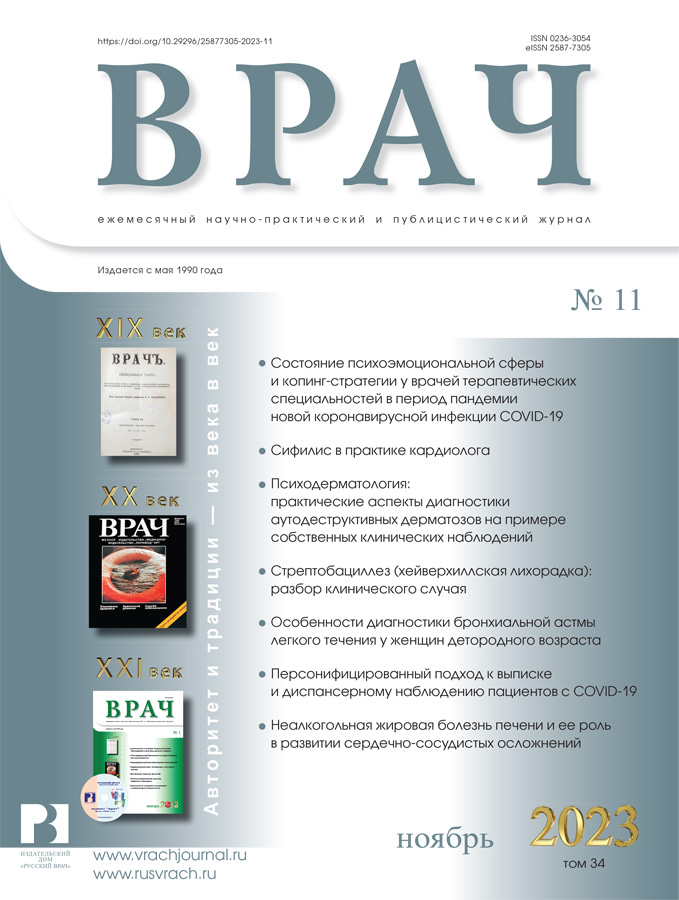Psychodermatology: practical aspects of diagnosing autodestructive dermatoses on the example of our own clinical observations
- 作者: Tlish M.M.1, Shavilova M.E.1
-
隶属关系:
- Kuban State Medical University, Ministry of Heath of Russia
- 期: 卷 34, 编号 11 (2023)
- 页面: 16-20
- 栏目: For Diagnosis
- URL: https://journals.eco-vector.com/0236-3054/article/view/624381
- DOI: https://doi.org/10.29296/25877305-2023-11-04
- ID: 624381
如何引用文章
详细
The study of the features of the relationship between the mental state of the patient and skin pathological processes at the present stage is especially relevant. This is due not only to an increase in the prevalence of psycho-dermatological comorbidity, but also to the pathogenetic features of the formation of the clinical picture of this pathology, which make it difficult to diagnose. Skin lesions can either be a consequence of a primary psychiatric illness or induce the development of concomitant psychosocial illnesses. At the same time, mental disorders masked by skin manifestations combine, as a rule, skin lesions due to self-harm. Their clinical picture can mimic the symptoms of a number of nosologies, including not only dermatological pathology, but also systemic diseases with skin manifestations. The artificiality of rashes may not always be obvious, which often leads to the erroneous involvement of doctors of various specialties in the diagnostic search and prolongs the time for making the correct diagnosis.
The article presents our own clinical observations of patients with autodestructive dermatosis, in which the verification of the diagnosis was accompanied by diagnostic errors, which caused pronounced destructive changes. In the analysis of the above clinical observations, attention is focused on the features of the skin pathological process, aspects of differential diagnosis, as well as insufficient awareness of primary health care professionals about this problem. Increased awareness of doctors of related specialties can contribute to clinical alertness, reduce the time of diagnosis and timely start of therapy for these patients by a psychiatrist, which will reduce the risk of an increase in the severity of the disease and social exclusion of patients.
全文:
作者简介
M. Tlish
Kuban State Medical University, Ministry of Heath of Russia
Email: marina@netzkom.ru
ORCID iD: 0000-0001-9323-4604
Professor, MD
俄罗斯联邦, KrasnodarM. Shavilova
Kuban State Medical University, Ministry of Heath of Russia
编辑信件的主要联系方式.
Email: marina@netzkom.ru
ORCID iD: 0000-0002-5776-6221
Candidate of Medical Sciences
俄罗斯联邦, Krasnodar参考
- Zhang X., Wang A., Shi T. et al. The psychosocial adaptation of patients with skin disease: a scoping review. BMC Public Health. 2019; 19: 1404. doi: 10.1186/s12889-019-7775-0
- Pondeljak N., Lugovic-Mihic L. Stress-induced interaction of skin immune cells, hormones, and neurotransmitters. Clin Ther. 2020; 42 (5): 757–70. doi: 10.1016/j.clinthera.2020.03.008
- Ferreira B.R., Jafferany M., Misery L. Psychodermatology in the Era of COVID-19. J Clin Aesthet Dermatol. 2021; 14 (3 Suppl 1): 24–7.
- Tohid H., Shenefelt P.D., Burney W.A. et al. Psychodermatology: an association of primary psychiatric disorders with skin. Rev Colomb Psiquiatr (Engl Ed). 2019; 48 (1): 50–7. doi: 10.1016/j.rcp.2017.07.002
- Jafferany M., Mkhoyan R., Arora G. et al. Treatment of skin picking disorder: interdisciplinary role of dermatologist and psychiatrist. Dermatol Ther. 2020; 33: e13837. doi: 10.1111/dth.13837
- Gieler U., Gieler T., Peters E.M.J., et al. Skin and psychosomatics – psychodermatology today. J Dtsch Dermatol Ges. 2020; 18 (11): 1280–98. doi: 10.1111/ddg.14328
- Ferreira B.R., Jafferany M., Patel A. Classification and terminology of psychodermatologic disorders. In: Jafferany M., Ferreira B.R., Patel A., authors. The Essentials of Psychodermatology. Switzerland AG: Springer International Publishing, 2020.
- Адаскевич В.П., Кирпиченко А.А., Морозова О.В. Психодерматология как важный компонент профессиональной подготовки дерматолога. Психиатрия, психотерапия и клиническая психология. 2019; 10 (4): 741–8 [Adaskevich U., Kirpichenka A., Marozava A. Psychodermatology as an important component of professional training of dermatologist. Psychiatry Psychotherapy and Clinical Psychology. 2019; 10 (4): 741–8 (in Russ.)].
- Torales J., Diaz N.R., Barrios I. et al. Psychodermatology of skin picking (excoriation disorder): a comprehensive review. Dermatol Ther. 2020; 33: e13661. doi: 10.1111/dth.13661
- Torales J., Villalba J., Ruiz Diaz N., et al. Excoriation disorder. In: Torales J, Malatesta E, eds. Psychodermatology: a diagnostic and therapeutic update of the most frequent clinical entities. Asuncion: EFACIM, 2019.
- Тлиш М.М., Глузмин М.И., Сычева Н.Л. и др. Случай аутодеструктивного дерматоза, имитирующего гангренозную пиодермию: клинический случай. Кубанский научный медицинский вестник. 2022; 29 (6): 84–95 [Tlish M.M., Gluzmin M.I., Sycheva N.L. et al. Self-destructive dermatosis mimicking pyoderma gangrenosum: a clinical case. Kuban Scientific Medical Bulletin. 2022; 29 (6): 84–95 (in Russ.)]. doi: 10.25207/1608-6228-2022-29-6-84-95
- Тлиш М.М., Карташевская М.И. Аутодеструктивный дерматоз как актуальная междисциплинарная проблема. Врач. 2018; 29 (4): 32–5 [Tlish M.M., Kartashevskaya M.I. Self-destructive dermatosis as an urgent interdisciplinary problem. Vrach. 2018; 29 (4): 32–5 (in Russ.)]. doi: 10.29296/25877305-2018-04-05
- Goulding J.M., Mughal F. Self-induced skin conditions: differential diagnosis and management. Br J Gen Pract. 2019; 69 (686): 464–5. doi: 10.3399/bjgp19X705449
补充文件







